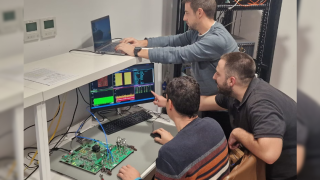For 5G to function effectively, different types of spectrum need to work in harmony, and that’s exactly what the operators will be able to do because of the auction.
In addition to most UK operators increasing their mid-band spectrum holdings (Three acquired only low-band spectrum but still holds by far the most mid-band of any operator), EE, O2, and Three also added low-band spectrum to their 5G offerings. As more and more people continue to rely on connectivity for nearly every facet of daily life, the low-band spectrum acquired at auction should allow for more widespread 5G availability to go along with the already fast speeds we’ve seen on 5G in the UK.
All four major operators have been using mid-band spectrum for 5G as it provides an ideal combination of fast speeds plus wide coverage. Indeed, our testing has shown impressive 5G speeds in the UK dating back to initial deployments, and over time, those speeds have generally continued to increase, with most operators today clocking excellent 5G median download speeds of at least 100 Mbps in most cities.
With 5G still in its relative infancy, however, we’ve also seen that, with some exceptions, 5G availability has often shown some room for improvement. The good news is that we’re seeing higher 5G availability in our early 2021 testing compared to what we saw in 2H 2020. In London, for instance, all four operators’ 5G availability in 1H 2021 was higher than it was in the second half of last year, with EE providing the most widespread 5G availability in the city at 43.7%.
The addition of low-band spectrum from the auction could expand the operators’ availability even further going forward, both in London and beyond. It’s also worth noting that even though Vodafone was the only operator that didn’t invest in 700MHz low-band spectrum at auction, Vodafone has a strategy to refarm its existing 900MHz spectrum for 5G to expand its availability, and the operator is also using DSS to boost 5G availability with its existing 4G LTE spectrum. Vodafone also has 90MHz of speedy mid-band spectrum at its disposal.
Given the growing importance of connectivity across the UK, the extra bandwidth gained at auction should lead to faster speeds plus broader 5G coverage going forward. As all four operators have increased their spectrum holdings, either by adding more mid-band or supplementing that mid-band with low-band spectrum (or by using DSS), we could see connected communities extend outside of major cities and into villages and rural areas where connectivity has previously been unreliable or even unavailable.
Low- and mid-band spectrum working together
Low-band spectrum, which is below 1GHz, can travel long distances and penetrate indoor structures well. Capable of reaching rural areas and other underserved communities, low-band spectrum provides 5G (or 4G) connectivity and can deliver coverage in garages, buildings, and other areas where connectivity can be problematic. While low-band is generally slower than mid-band, the tradeoff with low-band spectrum—broader coverage but slower speeds—can often be mitigated when paired with mid-band, which is in the 1-6GHz frequency range.
In addition, low-band spectrum in combination with mid-band spectrum can support the growth of IoT applications, which demand widespread, powerful connectivity at both indoor and outdoor locations. 5G is thought to be the sole technology capable of supporting the innumerable connected “things” that will make up the huge IoT network, and low-band spectrum combined with mid-band could prove vital in the IoT’s development.
Ultimately, 5G will play a critical role in the infrastructure needed to support an increasingly connected and “smart” society, enabling a host of industrial IoT applications like smart warehouses, as well as entire smart cities and the web of connected “things” that make those cities smart. For example, 5G could help enable smarter transportation, safer roads, and even help with pollution. The ability to see what’s ahead on the road in real time will help support autonomous transportation systems, and real-time data processing will also allow for automatic monitoring of sharp rises in air pollution, leading to smart road closures and diversions to assure people remain in areas with safe air quality.
DSS also used to expand 5G
Dynamic spectrum sharing (DSS) technology will also be key to expanding 5G. DSS allows operators to increase 5G availability by using existing 4G spectrum and dynamically sharing it for 5G service. As operators take advantage of different types of spectrum and 5G coverage is expanded using DSS and/or with low-band spectrum assets, we could witness a turning point for 5G in which operators can exploit all of their different spectrum assets, including DSS and other refarming strategies. It’s also key to keep in mind that one type of spectrum isn’t necessarily “better” than another. They’re merely different, and an optimal 5G experience will be one in which different spectrum types work together.
Putting it all together
When evaluating 5G, it’s important to consider more than just speed. A comprehensive view means looking beyond the term “5G” to understand the types of spectrum that power that 5G. To design a comprehensive 5G strategy, operators must balance the need to deliver strong performance in highly congested urban areas while also providing good performance and coverage in rural and other environments where signals often struggle to cope with certain architecture and topography.
The good news is that the significant investments we saw at auction have put all four operators in an excellent position to meet those needs and continue delivering 5G service that’s not only fast, but also more widely available.





